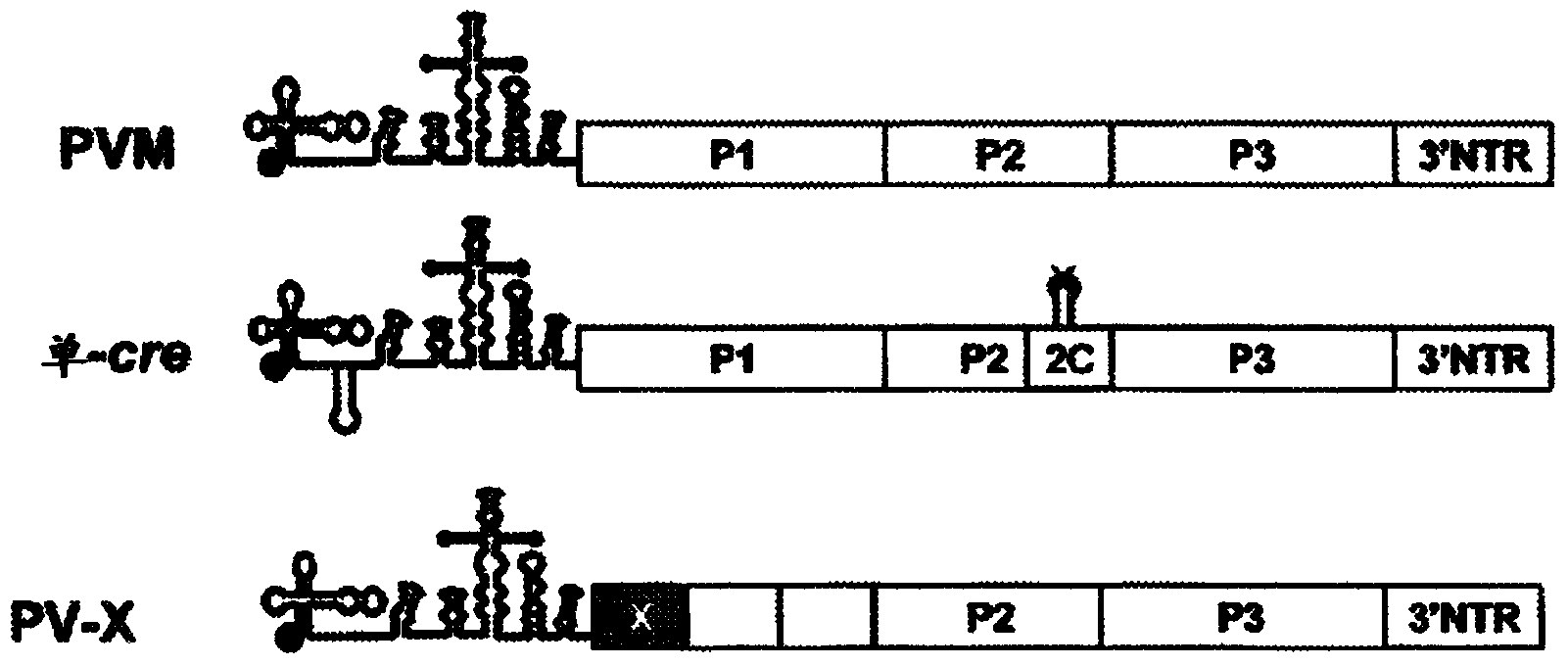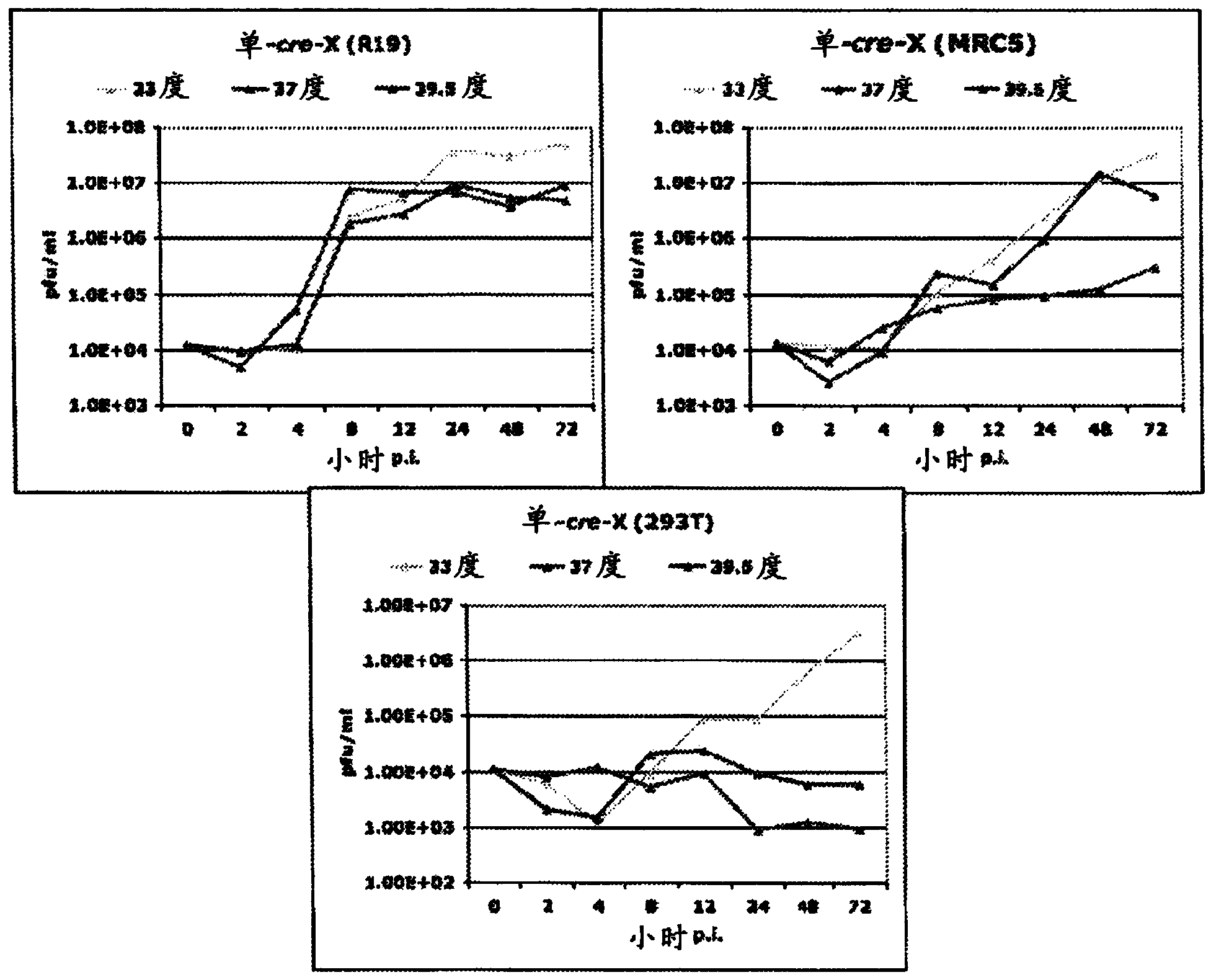Novel attenuated poliovirus: PV-1 mono-cre-X
A polio virus technology, applied in the field of new attenuated polio virus, can solve the problem of attenuation
- Summary
- Abstract
- Description
- Claims
- Application Information
AI Technical Summary
Problems solved by technology
Method used
Image
Examples
Embodiment 1
[0073] Specific infectivity and attenuation of poliovirus and recombinant vaccine candidates.
[0074] Comparison of specific infectivity and attenuation of recombinant poliovirus vaccine candidates with PVM wild-type poliovirus. Viruses were grown on HeLa cells. Virus particle concentration was measured by optical density (1OD 260 =9.4x10 12 particles / ml). Plaque forming units / ml were determined by HeLa(R19) plaque assay and the ratio of viral particles to PFU was calculated. Relative specific infectivity was determined by normalizing particles / PFU to wild-type values. The virus was administered to CD155 transgenic mice (which express the PV receptor) by intracerebral injection, and the dose causing paralysis in 50% of the mice was determined (PLD 50 ).
[0075] Table 3 shows that engineering of the cre element in the genome of wt PV significantly reduced the neurovirulence and relative specific infectivity of the virus. Surprisingly, characterization of PV1-X showed t...
Embodiment 2
[0079] Viruses with back mutations are neuroneurally attenuated.
[0080] Neuroattenuation of polioviruses is usually caused by mutations at a small number of positions. For example, point mutations within the IRES of the Sabin poliovirus vaccine strain are determinants of the attenuated phenotype. Thus, such attenuated polioviruses frequently revert to the fully neurotoxic wild-type phenotype. After repeated passage in neuronal cells, PV1-mono-cre virus (Ld 50 >10 8 ) and PV1-mono-cre-X virus (Ld 50 >10 8 ) shows A 133 G mutation, which increases neuropathy in mice, although the mutated virus compared with wt poliovirus (LD 50 =10 1.9 ) is still attenuated. A 133 GPV1-mono-cre virus and A 133 LD of G PV1-mono-cre–X virus 50 10 respectively 4.5 and 10 5.6 .
[0081] The relative specific infectivity of PV1-mono-cre virus and PV1-mono-cre-X virus was 0.25 and 0.084, respectively. At the same time, A 133 G PV1-mono-cre virus and A 133 The relative specific infec...
Embodiment 3
[0084] Plasmid construction and DNA manipulation.
[0085] Neurovirulent poliovirus type 1 (Mahoney) is the strain used in the laboratory (Cello, 2002). The poliovirus cDNA sequence was that used for cDNA synthesis by Cello et al. (2002) (plasmid pT7PVM) (van der Werf, et al., 1986, Proc Natl Acad Sci USA 83:2330-4). "pT7PVMcre(2C ATP酶 ) mutant” is a full-length poliovirus cDNA clone, in which 2C ATP酶 The native cre element in the coding region was inactivated by introducing three mutations at nt4462 (G to A), 4465 (C to U) and 4472 (A to C) (Yin, et al., 2003, J. Virol. 77 : 5152–66; Paul, 2003, In: Semler BL, Wimmer E, eds. Molecular biology of picornaviruses. Washington (DC): ASM Press; 2002. pp. 227–46; Rieder, et al., 2000, J. Virol .74:10371–80). The dual-cre PV is a derivative of pT7PVM with two active cre elements; one at nt102 / 103 of the 5'-NTR on which a new NheI restriction site is created. The second cre element at 2C ATP酶 in the coding region ( figure 1 A)....
PUM
 Login to View More
Login to View More Abstract
Description
Claims
Application Information
 Login to View More
Login to View More - R&D
- Intellectual Property
- Life Sciences
- Materials
- Tech Scout
- Unparalleled Data Quality
- Higher Quality Content
- 60% Fewer Hallucinations
Browse by: Latest US Patents, China's latest patents, Technical Efficacy Thesaurus, Application Domain, Technology Topic, Popular Technical Reports.
© 2025 PatSnap. All rights reserved.Legal|Privacy policy|Modern Slavery Act Transparency Statement|Sitemap|About US| Contact US: help@patsnap.com



